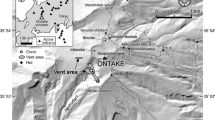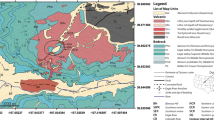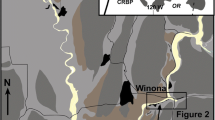Abstract.
Six years after the 1991 Mt. Pinatubo eruption, deep erosion incisions into the pyroclastic deposits accumulated around the volcano enabled us to investigate the stratigraphy of the climactic deposits both in valley bottoms and on contiguous ridges. Stratigraphic relationships between fall, flow, and surge deposits in the Marella drainage system indicate that during the climactic eruption a progressive shift occurred from an early convective regime, to a transitional regime feeding both the plinian convective column and mostly dilute density currents, to a fully collapsing regime producing mostly dense pyroclastic flows. Syn-plinian dilute density currents (surges) propagated up to ~10 km from the crater, both along valley bottoms and on contiguous ridges of the Marella Valley, whereas post-plinian pyroclastic flows had greater runout (~13 km), were confined to valleys and were not associated with significant surges. Stratigraphic study and grain-size analyses allow the identification of three types of intra-plinian deposits: (a) lower and often coarse-grained surge deposits, emplaced during the accumulation of the coarsest portion of the fallout bed at time intervals of ~16–24 min; (b) upper fine-grained surge deposits, interstratified with the fine-grained portion of the fall bed and emplaced at shorter time intervals of ~3–13 min; and (c) small-volume, channel-confined, massive pumiceous flow deposits interbedded with the upper surges in the upper fine-grained fall bed. Maximum clast size isopleths of 1.6 and 0.8 cm for lithics (ML) and 2.0 and 4.0 cm for pumices (MP) show almost symmetrical distribution around the vent, indicating that the passing of the typhoon Yunya during the climactic eruption had little effect on trajectories of high-Reynold-number clasts. Significant distortion was, however, observed for the 3.2-cm ML and 6.0-cm MP proximal isopleths, whose patterns were probably influenced by the interaction of the clasts falling from column margins with the uprising co-ignimbrite ash plumes. Application of the Carey and Sparks (1986) model to the undisturbed isopleths generated by the umbrella cloud yields a maximum column height of ~42 km, in good agreement with satellite measurements. Systematic stratigraphic and vertical grain-size studies of the plinian fall deposit in the Marella Valley, combined with satellite data and eyewitness accounts, reveal that the carrying capacity of the convective column and related fallout activity peaked in the early phase of the eruption, beginning slightly before 13:41 and gradually declined until its cessation 3 h later. Most of the pumiceous pyroclastic flow deposits were emplaced after the end of the fallout activity at ~16:30 but before the summit caldera collapse at approximately 19:11. Only a small volume of pumiceous flow deposits accumulated after the final caldera collapse. In contrast to the previous reconstruction of Holasek et al. (1996), which interpreted the progressive lowering of the column, documented by satellite data, as due to a decreasing mass eruption rate, we suggest that a progressive shift from a plinian column to a large co-ignimbrite column could also account for such a variation.
Similar content being viewed by others
Author information
Authors and Affiliations
Additional information
Electronic Publication
Rights and permissions
About this article
Cite this article
Rosi, .M., Paladio-Melosantos, .M., Di Muro, .A. et al. Fall vs flow activity during the 1991 climactic eruption of Pinatubo Volcano (Philippines). Bull Volcanol 62, 549–566 (2001). https://doi.org/10.1007/s004450000118
Received:
Accepted:
Issue Date:
DOI: https://doi.org/10.1007/s004450000118




